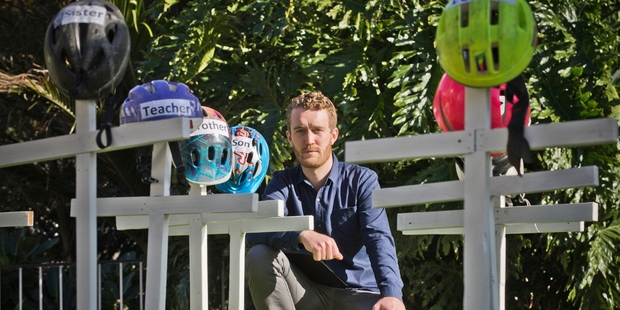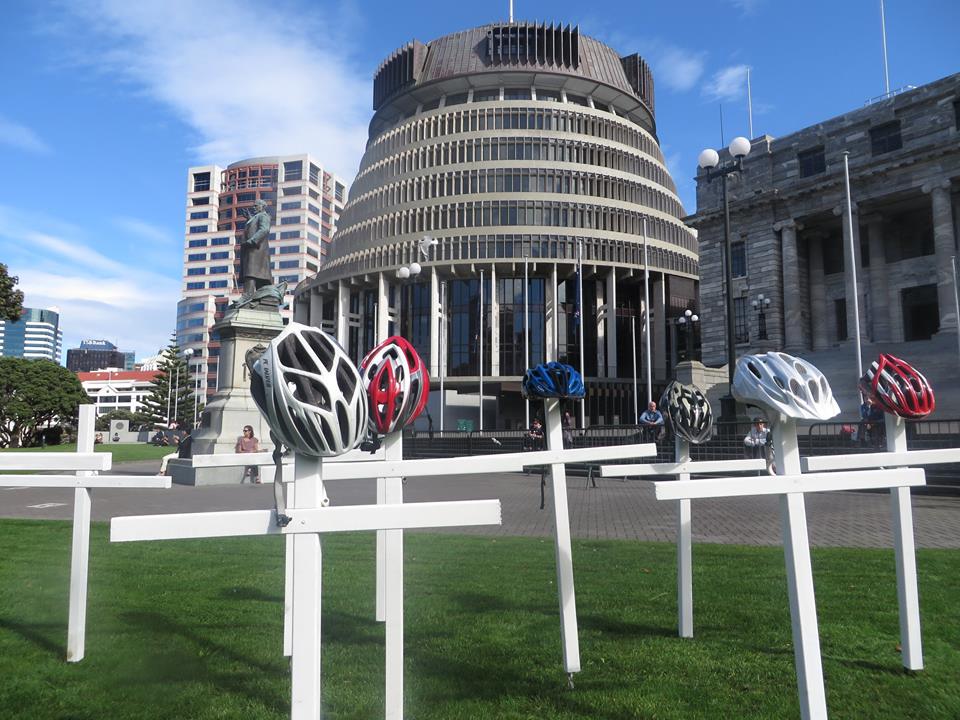Following last month’s tragic cycling incident in Hillmorton, yesterday’s Press reports (on the front page no less) that the victim’s father is now too scared to ride himself. It’s perhaps an understandable reaction, although I wonder whether the real issue is the perceived safety of cycling rather than the actual safety.
The morning after the incident, I was riding to work as usual and caught up with another colleague who was also biking there. Noting my (usual) non hi-vis everyday attire, he pointed to his own hi-vis jacket and said “my wife specifically asked me to wear it this morning”. It’s a sweet thought to think of one’s loved ones showing concern like that – but had anything really changed safety-wise between that day and the day before? I suspect if anything that, in light of the previous day’s news, motorists were probably more careful than normal around those on bikes…
Cycling safety is a tricky issue to deal with in public; certainly I have to grapple a bit with how it gets portrayed on this blog for starters. Yes, it’s understandable to show concern for something we think could be safer. But I think often in raising awareness about cycle safety, an “own goal” is scored instead. Individuals or groups might loudly claim “cycling is dangerous! we need to make it safer!”; however I suspect all that many of those listening think is “gosh, cycling is dangerous? I don’t think I’ll do that then…”
This is a particular trap that advocacy groups need to be wary of. Yesterday, The Press also reported on Spokes Canterbury presenting to the City Council’s Annual Plan Hearings, and led with the dramatic statement that Chch roads are a “deathtrap” – “No-one will die if Christchurch does not get a new sports stadium, but people will die if better provisions are not made for cycling in the city.” Meanwhile, at the other end of the country, a group of Auckland “cyclists” erected a graveyard of crosses in front of the Auckland Council building to highlight their concerns about cycle safety in the City of Sails.

This latter exercise mirrors an earlier campaign last month by the Cycling Advocates Network (CAN) to hold a series of memorial rides around the country to draw politicians’ attention to cycle safety and commit parties to upholding the recommendations that come out of the national Expert Panel currently investigating cycle safety in NZ. Interestingly, when Spokes discussed whether to hold such a ride here they decided to focus on the positive aspects of cycling instead – the result is this Sunday’s “Cycle Colombo” activity (hope to see you there!).
It’s one thing for advocacy groups to have private conversations with the relevant agencies and say “hey, we think cycling could be safer here; what can you do?” But you just know that if the discussion is aired publicly instead, the media will go nuts about “Cycle danger highlighted”. I suspect they sometimes think they’re doing the public a favour by bringing to attention these concerns (and something might get “done”). Except that we know that the best cycle safety measure is simply more people cycling, i.e. safety in numbers. So once again putting cycle safety on the front page (unlike “just another motorist death” relegated to page 5…) merely raises a false perception of cycling as this clearly death-defying activity.
So what’s the actual safety of cycling in NZ? I thought I’d share a chart that we’ve been playing around with in the Cycle Safety Expert Panel. It compares the relative cycle fatality rate per kms ridden for a number of countries that have appropriate travel data available (not many actually):
 Now I hesitate slightly to put this chart out in public because these things tend to get picked up and used as a rallying call tool: “See! Our cycle safety record is terrible – why can’t we be like The Netherlands or Denmark?” The problem I have with this is twofold:
Now I hesitate slightly to put this chart out in public because these things tend to get picked up and used as a rallying call tool: “See! Our cycle safety record is terrible – why can’t we be like The Netherlands or Denmark?” The problem I have with this is twofold:
- Firstly, our road safety record in general is not good compared to those better performing countries; typically our crash rate is double some of theirs. Yet, I don’t see a lot of people in NZ having mass demonstrations and crying “Our road safety record is terrible – why can’t we be like The Netherlands or Denmark?“
-
- Secondly, none of the numbers shown are big. Have another look at the NZ figure: 28 fatalities per billion km. That’s one fatality for every 35 million km ridden. How many kms have you ridden lately? Comparing countries is a bit like comparing the risk of being struck by a meteor or being struck by a falling plane – I don’t tend to lose much sleep over either.
As I’ve explained before, cycling is actually a very safe activity in NZ; even your risk of getting injured (let alone killed) is miniscule and that’s before we even consider the considerable health benefits that outweigh those safety concerns. The reason cycle accidents end up on the front page is because they are rare. By all means, let’s work to achieve an even better cycling environment out there. But let’s not get off our bikes in the meantime while we wait for that to happen – that just disadvantages you…

What do you think? Is cycling safety in NZ a real concern or mostly a perceived one?


The Auckland protest was done by a quite random group of activists. The Generation Zero campaigns I’m involved have deliberately stayed away from raising these issues so blatantly, as we have done our homework, and come to same conclusions as you. Not great to focus on the safety aspect, really need to get better infrastructure so people feel much safer cycling.
Excellent points, “Lennyboy”. An additional point in relation to peoples assessment of risk: cycling is less safe than car travel by about the same factor (10) that car travel is less safe than Public transport. But few people take accident risk into account in deciding whether to travel by car or bus.
Good points, though you should put this in perspective of cycling risk compared to other modes. MoT data from 2009 shows that in terms of per 100 million km traveled, cyclists rate of serious injuries/fatalities is 10 times that of a car driver. You can also compare modes using time (accounts for the fact that cycling is a generally slower mode), where cyclists rates of serious injuries/fatalities per million hours traveled are 2-3 times that of a car driver. I would argue that although the actual risk rate is still small, the disparity in risk between modes is significant and a serious cause for concern, and likely linked to negative perceptions of cycling as a safe mode of travel.
Sadly, rates of injury/death for motorcyclists are far worse (~25 times the risk in comparison to car drivers). New Zealand has a long way to go to improve accident risks for all users.
The biggest problem with the “official” MoT stats is that they aggregate everyone’s experiences together, but you’re not comparing the same groups of people or scenarios. So, for example, the inexperienced 10-year-old riding their bike in a busy street environment is compared with the mature 40-year-old driving their car on a fully-protected motorway. If you look at particular sub-groups, the stats are not always so stark. For example, 15-19-year-olds are safer biking than driving in NZ.
Here’s another interesting link on the subject….
http://www.vox.com/2014/5/16/5720762/stop-forcing-people-to-wear-bike-helmets
Always good to see advocates ripping each other apart. Isn’t it annoying when someone does something about an issue, rather than just posting on the internet…
Has anyone looked at the ways other countries became “bike cities”. Did the Netherlands, Vancouver or other cities get there through silent advocacy and lobby meetings?
https://www.youtube.com/watch?v=XuBdf9jYj7o
Build it and the cyclists will come.
Bike promotion is the topic of my Master’s Thesis, so I’d like to think I’m doing something to promote cycling, and yes I do provide constructive criticism to the occasional blog :-). I imagine everyone else commenting here provides there own contribution to the cycling world in some way or form…
The chances of a fatal accident while cycling might be very small and the stats certainly do not deter me from cycling on safe roads but for me the point is that many fatal accidents are preventable. Too often saving a few bucks takes priority over cycling safety. Johns rd is a classic example. We spent millions and millions of money upgrading a motorway but can not find the money to keep cyclists safe.
I have a feeling that safety is the excuse used by people that have other reasons for not cycling. If someone says they do not cycle because it is unsafe it stops the conversation. If they said they run the kids to school because they can’t be bothered getting up early enough to get them ready they would lose face. It also fills up their day so they can tell their friends how busy they are.
The degree of the safety barrier should be very easy to research in Christchurch. We have a number of schools with quite safe cycling access, most of them border the dedicated trail beside the railway corridor from Riccarton to Papanui. If safety is the main barrier the numbers travelling to school by bike should be significantly higher at those schools.
Does anyone have any figures on this?
I do find that us cyclists are expected to just deal with the motorists out there, and that we are fighting the safety issue the wrong way with helmets, hi-visibility items, etc. Not only are they a false sense of security, they also discourage cycling to fashion-conscious people or those who prefer to be comfortable when riding.
However, I completely disagree that motorists or “cagers” are always to blame. More often than not I have observed completely unfocused cyclists who “fall asleep” at the bars, thinking that their hi-visibility jacket and flashing lights will prevent an accident. The safest way to ride a bike is to stay alert, don’t expect ANY car to be nice to you, or observant of you, and read the traffic patterns, such as T-Intersections, pay attention to the cars approaching said intersection, and perhaps give yourself a foot or two more space than you would otherwise, just in case he pulls out too far, or pulls out too suddenly.
I’ve been riding in black clothing (my preferred colour choice) for well over 10 years, completely unscathed by motorists. I don’t even own a set of lights… It’s just a matter of being comfortable, confident, and alert, and knowing just how to react when something does go pear-shaped, or at least becomes a little bit difficult to judge.
In the very worst of situations, find an alternate route, sift through the between-streets of the city, remember that you don’t need traffic lights to meet your destination quickly, you can’t get stuck in a 40-car waiting list at each intersection… and should you find a road too difficult to cross, jump off your steed and walk it.
And remember, you can react much faster on a bicycle than a fellow motorist can, if a situation is to go sour, you can easily pull out of it, or at the very least lower the accident’s severity.